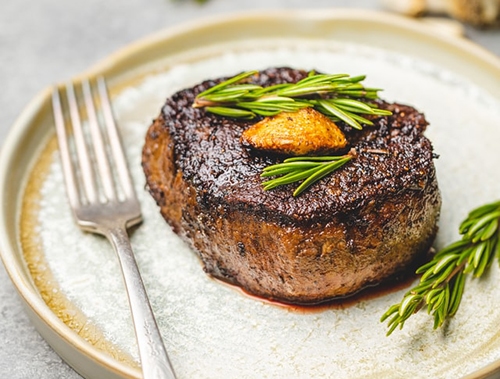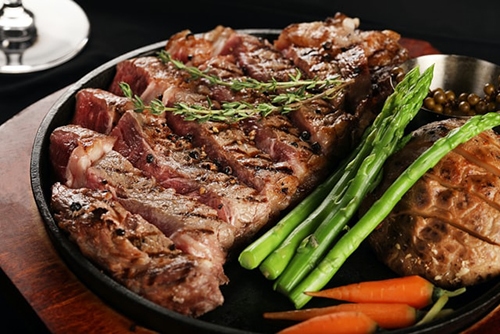Are There Subgrades of Select Grade Beef
Prime beef is the highest quality of beef, with choice being the second highest, and select being last in the rating system.
When I first started culinary school, I got a lot of questions from family members about prime vs. choice vs. select beef - often when they were in line at the butcher counter. Due to this, I've got my answer all figured out!
In this post, you will learn about the beef grading system, what each of these labels mean, and when to use each type of beef. Let's begin!
The USDA Grades for Beef
The USDA grades beef according to two criteria: the degree of marbling on the beef and the age of the animal at the time of slaughter. Marbling refers to the intramuscular fat in beef which presents as white flecks.

Here is a better understanding of how what this grading system actually means:
- Prime: this is the highest grade of US meat that is derived from young, well fed beef cattle. This meat has plenty of marbling, around to 8 to 13 percent of fat. USDA prime beef is rare, with around only 2 percent of beef receiving this grade. You often find this meet in gourmet restaurants.
- Choice: choice graded beef is a bit more readily available and while the meat is superior, it has less marbling than prime beef. There is often around 4 to 10 percent fat in choice beef. Certified Angus beef is one of the most common examples of USDA choice meat.
- Select: this is the most widely available grade, present in many grocery stores, but this doesn't mean that it isn't good quality. Rather, it is a leaner meat with only 2 to 4 percent marbling. Although it is tender, it can lack the juiciness and flavor of the other two beef grades.
Related Reading
- Smoked Sirloin Tip Roast: A Must Try Recipe
- Smoked Eye of Round Recipe (Easy & Delicious!)
- Poor Mans Burnt Ends: The Best Ever Recipe
- Costco Tri Tip Recipe (Great Value & Easy to Cook)
Is Choice, Select, or Prime Better?
As mentioned, prime beef is awarded the highest quality grade. Do these meat grades actually mean anything, though? Is there a significant difference between the grades of beef and, if so, why?
Here is what you should know:
The marbling on the beef is what gives meat a great taste and texture. This fat keeps the tender and moist. When you cook meat with more marbling, the fat melts carrying flavor and tenderness throughout the entire slab of meet.
Meat with a low marbling score, though, has a tendency to dry out compared to one with abundant marbling. There is also less flavor.
This is why when the choice is between prime, choice, or select, prime is the best. Of course, this doesn't mean that prime is the only way to go. If you are looking for a cheaper option, choice beef can be just as great. And, select is pretty good too!
How is Beef Graded?
There is more to higher grades than people realize. If you want to really understand how beef is graded and what meat you should be searching for, here is a closer look at what goes on behind the scenes:
Quality Grading
Quality grades are what most people are familiar with. It is what considers the level of marbling and maturity of the animal when assigning a grade. As you will have seen from the previous section - prime grade, choice grade, and select grade are the top options.
After this, you have standard grades, commercial grades, utility grades, cutter grades, and canner grades.
When it comes to marbling, there are several levels:
- Slightly Abundant
- Moderate
- Modest
- Small
- Slight Traces
- Practically Devoid
With maturity, the age of the cow receives the corresponding rating:
- A — 9 to 30 months
- B — 30 to 42 months
- C — 42 to 72 months
- D — 72 to 96 months
- E — more than 96 months
Beef with slightly abundant marbling and an A rating are considered prime cuts. Modest and A is choice, and Slight and A is select.
With commercial grades, there is a moderate amount of marbling, but the maturity of the cow has a C and D rating. Cutter grades have the same maturity rating but even less marbling.
Yield Grading
Few people out of the industry are aware of yield grades. This is an estimate of beef carcass cutability. This, in turn, is defined as the combined yield of closely trimmed, boneless retail cuts (CTBRC). Essentially, it is a way to determine how much usable lean meat is available.

The grading system is broken down as such:
- 1 - less than 52.3 percent
- 2 - 50.0 to 52.3 percent
- 3 - 47.7 to 50.0 percent
- 4 - 45.4 to 47.7 percent
- 5 - less than 45.4 percent
When looking for USDA prime, select, or choice beef pay attention to the rating system as a whole. This will allow you to choose beef that is truly high quality. Being more informed also makes it more difficult for butchers to pull a fast one on you.
USDA Beef Grades vs. Grass Fed Beef
Once, the USDA grades of beef were the beginning and end of choosing good quality meat. These days, though, things have changed thanks to grass fed beef.
In the earlier days, grain fed beef were said to be the best. This was due to the fact that grass fed meat had a gamier taste and a meatier texture. Cows that were fed grain, on the other hand, had a sweeter more buttery flavor and a texture that melted in your mouth if it was cooked just right.
Things have changed quite a bit since then, however. For one thing, farmers have stepped up their game, allowing cattle to finish up on clover, ensuring that the meat tastes sweeter, much like the corn-fed cows.
Producers are also increasingly dry aging their meat. This improves both the traditional flavor as well as the texture.
There is also the fact that people's preferences are changing. Many are beginning to enjoy the complex flavors of the grass fed options, including the nutty notes.
It is interesting to note that there is no USDA grade for this type of beef, however. This is because, as stated, USDA inspectors assign grades based on the level of fat marbling the beef.
Grass fed meat, though, contains little to no marbling and as such, doesn't receive a grade. It is due to this that you shouldn't automatically assume that prime, choice, or select beef with a USDA grade is the only way to go.
Related Reading
- Where Does Steak Come From? (Explained)
- I Spy: Where is the Ribeye on a Cow?
- In the Know: How to Tell If a Steak is Bad
- Smoked Flank Steak: A Must Try Recipe
Frequently Asked Questions
Here are some of the most frequently asked questions regarding this topic:
Is Costco Prime Beef Really Prime?
Yes, this is actually USDA prime meat! It may be available in smaller quantities than what you are used to, but it is still good!
Is USDA Select Bad?
No, USDA select is still perfectly good beef as it is still one of the higher grades. It is not as good as prime or choice, but far from being subpar.
This is what you need to know about the different grades. With this information in hand, making the right choice for your next dish is going to be a lot easier. Not to mention, you don't have to worry about being misled into choosing unnecessarily expensive cuts of beef. Sometimes, a cheaper option can work just as well!

ByKristy J. Norton
I'm Kristy – a chef and connoisseur of all things BBQ! You can find me either in my kitchen (or someone else's) or at a big outdoor barbecue surrounded by friends and family. In both my professional and personal life I've picked up more than a few tips and tricks for turning out delicious food. I consider it a privilege to share it with others!
Source: https://catheadsbbq.com/prime-vs-choice-vs-select/


0 Response to "Are There Subgrades of Select Grade Beef"
Post a Comment